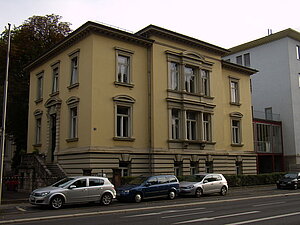Arthur Hantzsch
* 7. March 1857 in Dresden † 14. March 1935 ibid.
1875 Study of Chemistry at the University of Dresden
1880 Conferral of a doctorate at the Universität Würzburg under Johannes Wislicenus
1882 Postdoctoral lecture qualification in Leipzig
1885 Professorship at the Swiss Federal Institute of Technology in Zurich
1893 Return to the Julius-Maximilians-Universität Würzburg
1903 Transition to the University of Leipzig
In its “Scholar of the month”-Series, the Universitätsarchiv Würzburg wants to present a chemist in April 2018 for the first time in its’s existence. Prof. Dr. Arthur Hantzsch has successfully researched and taught at the Alma Julia for over ten years and has strongly influenced the chemical studies at our University through his various researches.
Versatile Theorist
Arthur Hantzsch was a tireless, visionary Chemist, who made a significant contribution to the chemical understanding of his time, by publishing more than 500 scientific papers about a comprehensive range of chemical fields. Amongst other things, he developed the Hantzsch pyridine synthesis in 1882. This reaction was used in the 1970s to synthesis nifedipine, which can be used as a calcium channel blocker in order to treat the coronary artery disease. Moreover, he also engaged himself with heterocyclic nitrogen compunds, the synthesis of pyrrole and its derivatives (Hantzsch pyrrole synthesis) and the distinction between acids and “pseudo-acids”.
Successful times
Despite being offered to do research in Kiel, Rostock or Worchester (USA), Hantzsch decided to return to Würzburg in 1893, where he already had his conferral of a doctorate under Johannes Wislicenus. He later called the ensuing time the most successful ten years of his life, as he was able to extensively dedicate himself to the research of nitrogen compounds and other important projects. As the successor of Emil Fischer, he also was responsible for the coordination of the relocation of the chemical institute from the Maxstraße 4 to the newly-build location at the Pleicher Ring 11 (today: Röntgenring), which was planned by Emil Fischer himself.
A well-established name
In addition to the two synthesis named after him, Hantzsch also was one of the eponyms for the Hantzsch-Widman-nomenclature and introduced the term “Pseudo-Säure” (Pseudo-Acid) to the organic chemistry. The influence of his researches were as significant, that the University of Leipzig, where he transferred to in 1903 even named a lecture room and an annual prize after him.




